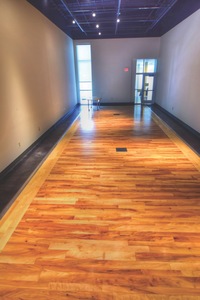

The gallery with its distinctive beech floor will host exhibits throughout the year. (photo by Dave Grace))
Dan Van Tassell, the new curator of the McGlothlin Center for the Arts Gallery and art instructor, is filled with enthusiasm and excitement.
One of the things he's excited about might not thrill the average gallery visitor. Indeed, they won't even see it. It's the panel system in the gallery storage area. The storage area has a full humidity and temperature control system and houses the college's permanent art collection. It also has a working section where guest artists' work can be uncrated, logged in and made ready for exhibit.
The panel system is custom built to fit the room and consists of metal panels that slide out so that artwork can be mounted to it. Its braking system holds the panels steady to keep artwork safe and provides an efficient use of space and safe storage.
The permanent collection consists of more than 300 works, primarily two-dimensional on paper or canvas.
"We have some fine craft as well," Tassell says. "That's an area I'd love to try and grow. This area is rich with tradition of fine craft and lots of people are saying contemporary things in fine crafts. We have some ceramics by Ben Owen and some small bronzes. Being a sculptor I'd love to see more 3-D, but that's a little selfish."
The collection is primarily 20th-century modern and contemporary work. The former chair of the art department George Chavatel donated one of the largest collections they have. There are some prominent artists in the college's collection, such as Dorothy Gillespie, Warrington Colescott and Frank Kleinholtz.
"Chavatel's work is interesting for students because it bridges a lot of different approaches to art," Tassel says. "It shows how his work changed throughout his life. We have a pretty broad collection of his work created over a period of time. It's a great educational resource for students as a physical representation of what they learn about in class. There's really no exchange for seeing the real thing and experiencing the real thing. I talk about that in lectures a lot. It's one thing to look at an image on a screen, but our experience is totally different when we experience it with all our senses. I think that's part of the beauty of having an art collection.
"We're looking to grow the permanent collection and for ways of putting it out on campus and showing people that is has the ability to communicate in many different ways and educate in a lot of different ways. The beauty of visual art is that it can be about anything. Art is freedom."
Tassel has plans for more than just hanging art on the wall in the gallery. He came from the University of North Dakota where he worked with a program called the Living Art Museum.
They curated exhibits for spaces in any building on the campus. For example, an exhibit on affirmative action was in the administration offices, an education themed-exhibit was displayed in the education building. "We accompanied each piece with a write-up explaining about the artist, what they were looking at and why it was there. We want them to understand that art isn't an afterthought; it's not just decoration or pretty. Someone was trying to communicate something through their art. That's what I'm trying to bring here."
Lisa Campbell, executive director, says when she interviewed Tassel she was looking for a partner she could work with and that what he does with art is what she wants to do with the performing arts.
"I came up through the ranks of education and outreach, and I'm passionate about using the arts to teach across the curriculum. During the search process I was looking for someone to play with, someone who gets it. I thought the Living Art Museum was an example of something that could be a model program."
Tassel says, "Part of my curatorial vision is that contemporary art is critically important to me. The past is important for our students to learn about and for contemporary artists to be able to reflect on. But I think it's critical for students and young artists to be able to see what's being talked about now. What is the visual dialogue we're having right now. We're a part of that dialogue. Although this is a rural area, we are not disconnected. I want students to get to meet contemporary artists and realize that they are real people, asking the same questions that we do. That was big realization for me when I was a youngster."
He is looking forward to learning more about the college's permanent collection and finding ways to share it with the community. There are spaces throughout the center where he plans to display portions of the collection when it isn't part of an educational exhibit on campus.
He says that he expects his ideas that use art to support other programs will be accepted. "I've noticed that everyone I've talked to has been excited about the possibilities. Everybody is totally into the idea, especially when they know you have a platform to do it."
The gallery is free and open to the public. Its hours are Monday through Friday 9 a.m. to 5 p.m., and from 12-5 p.m., on Saturdays. It is also open an hour before each Artalk and performance.
THERE'S MORE
-- The gallery floor